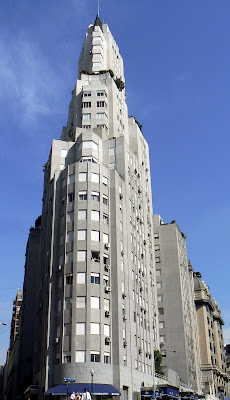When I travel, I usually take a guide book with me, and often come across references to Art Deco and Art Nouveau buildings, but to be quite honest I never really tried to find out what the difference was. I just knew that they both usually dated from the early twentieth century. However, after a recent trip to Riga, which has some of the finest examples of Art Nouveau architecture in the world, I finally started to get a grasp of what that was. It is quite a common style in big European cities. Art Deco, on the other hand, tends to be more prevalent in North and South America, with some of the finest examples being in New York.
PART ONE - ART DECO
Art Deco was a common style of design from the mid-1920s to the mid-1940s. It was intended to be elegant, sleek and modern. It took its name from the Internationales des Arts Décoratifs et Industriels Modernes held in Paris in 1925, but the term Art Deco was not widely used until it was popularized by art historian Bevis Hillier's 1968 book Art Deco of the 20s and 30s. So, how can you recognize it? Well, if you see a pre-war building with a streamlined look, then it's probably Art Deco. It is strongly influenced by the architecture of Ancient Egypt., with its pyramids and obelisks. If I tell you that the Empire State Building and Chrysler Building are Art Deco, then you'll start to form an image of what it looks like: tall and sleek, with geometric patterns and curves, sometimes with a sinister touch: think Superman and Gotham City. But, be warned, if it's got flowery designs and faces on the front, then it's more likely Art Nouveau.
In my opinion, Art Deco buildings can often be quite brutal and ugly, but here are three I've seen that I liked (photos from top to bottom):
1/ Edificio Kavanagh , Buenos Aires. When it was completed in 1936, Edificio Kavanagh was, with a height of 120 m, the tallest building in Latin America and the tallest reinforced concrete building in the world. it was designed in a style which is a mixture of Art Deco and Modernism (that's another story), by architects Gregorio Sánchez, Ernesto Lagos and Luis Maria de la Torre. There is a funny story attached to this building: it was planned as an act of revenge by the developer, Corina Kavanagh. One of Corina's daughters had fallen in love with the son of the aristocratic Anchorena family, who lived in a palace and had built a church next to the site of the Kavanagh Building. The Anchorenas stopped the marriage to a member of a nouveau riche family, whom they perceived as being below their social status. So, to teach them a lesson they'd never be able to forget, Corina Kavanagh decided to build a skyscraper that would block the view of the church from their palace. It took all of her inheritance to complete it, and she spent the rest of her life living in an apartment on the 14th floor of Edificio Kavanagh. It is, nevertheless, a beautiful building, and it certainly has a 'wow' factor, because that's what I said when I first saw it.
2/ Palacio Salvo, Montevideo. This 26-storey skyscraper, which dominates the skyline of Montevideo, was designed by the architect Mario Palanti, and constructed between 1925 and 1928. It is 95 metres high, but 100 metres with the antenna., and until the Edifico Kavanagh was completed eight years later, it was the tallest building in South America. Palacio Salvo may no longer be the tallest building in South America, but it is still the most popular image on postcards of Montevideo and remains a national icon for Uruguayans. I personally think it's one of the great pre-war skyscrapers, on a par with New York's Chrysler Building.
3/ Union Hotel, Bucharest. Eastern European cities have many impressive Art Deco buildings from the 20s and 30s. One of the most spectacular is Bucharest's Union Hotel, which was built between 1929 and 1931 by local architect Arghir Culina. It used to be a hotel, but is now used as an office block.
PART TWO - ART NOUVEAU







Now whe know and see !! Art deco was a reaction against Art nouveau (named "Art nouille" or noodle art ?), kind of reaction itself against abuses of industrialisation ! ;)
ReplyDeleteI'm waiting for part II ! and illustrations around the world !
I was in Montevideo in July 1968 and the Palacio Salvo is the only building I remember there. A few years ago, my husband and I were thinking of spending the winter in Uruguay (our winter, their summer) and, if I remember correctly, I found (online) a furnished apartment in that building.
ReplyDeleteThere was something about Montevideo that reminded me of London. I've never visited London, but Montevideo was cloudy and rainy, the buildings reminded me of ones I had seen in British films, and there were double-decker buses, too.
Dear Ian: I am from Buenos Aires, and I am quite glad you liked the Kavanagh building. A small correction though, the Salvio palace is considered Art nouveau rather than Deco, as it's twin brother, the Barolo Palace, in Buenos Aires (same architech, quite as lovely).
ReplyDelete